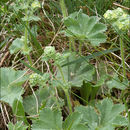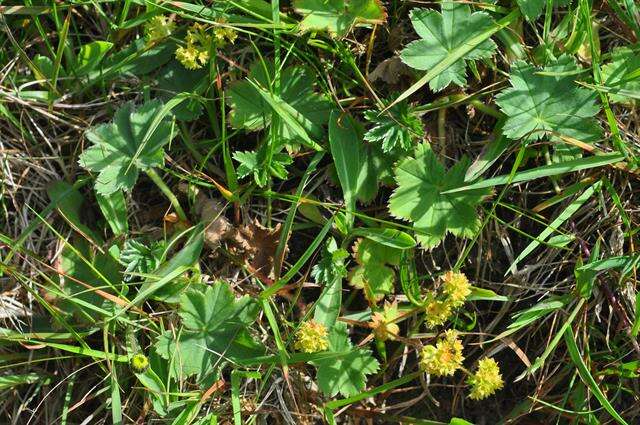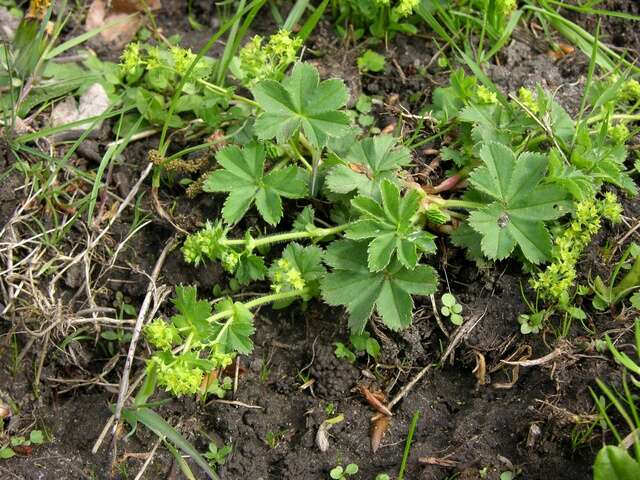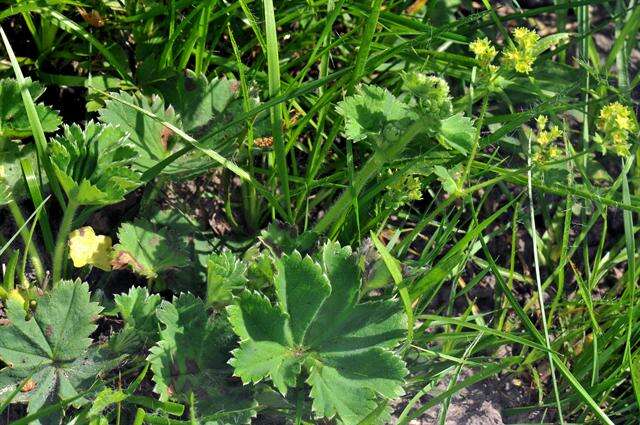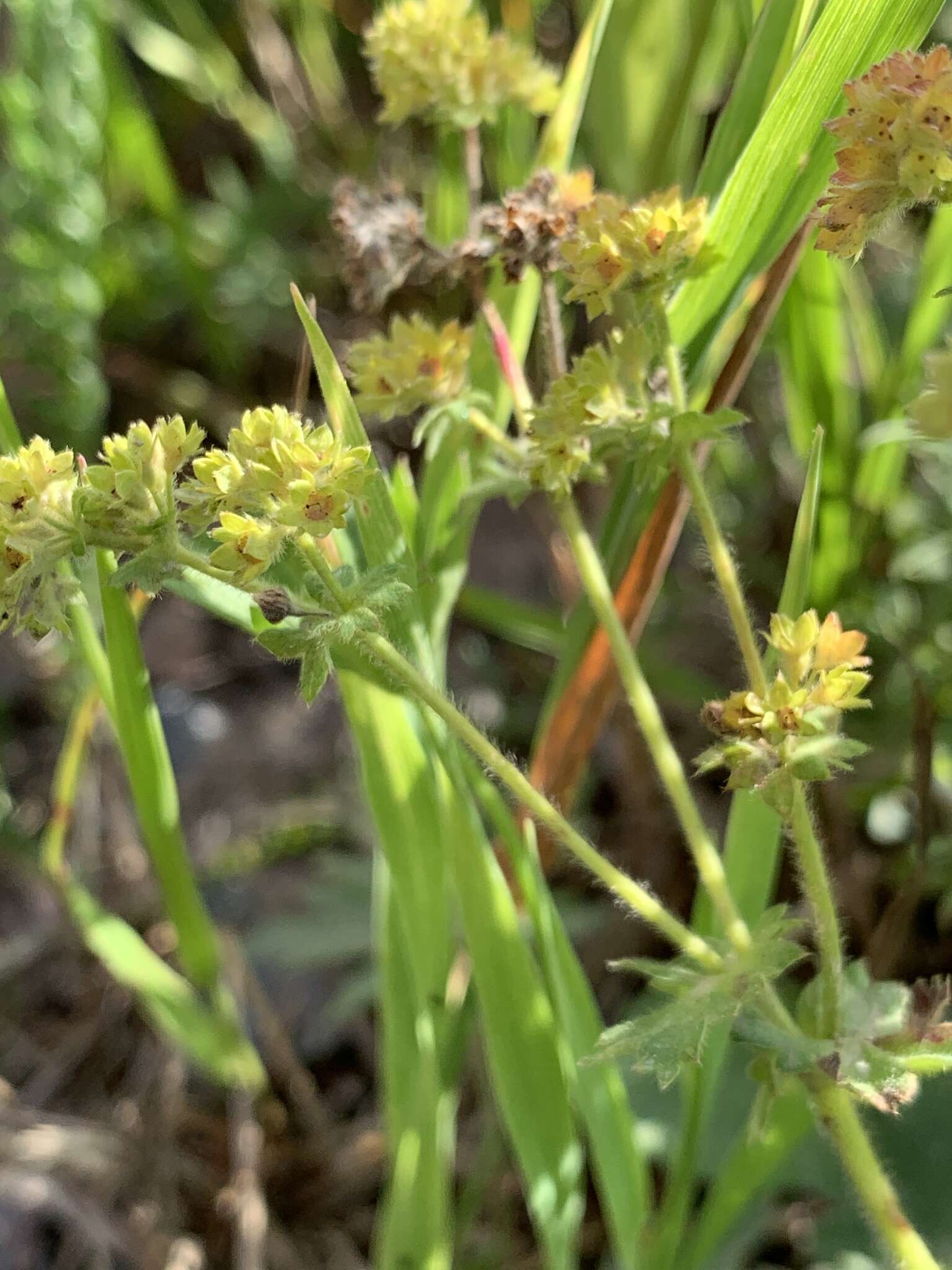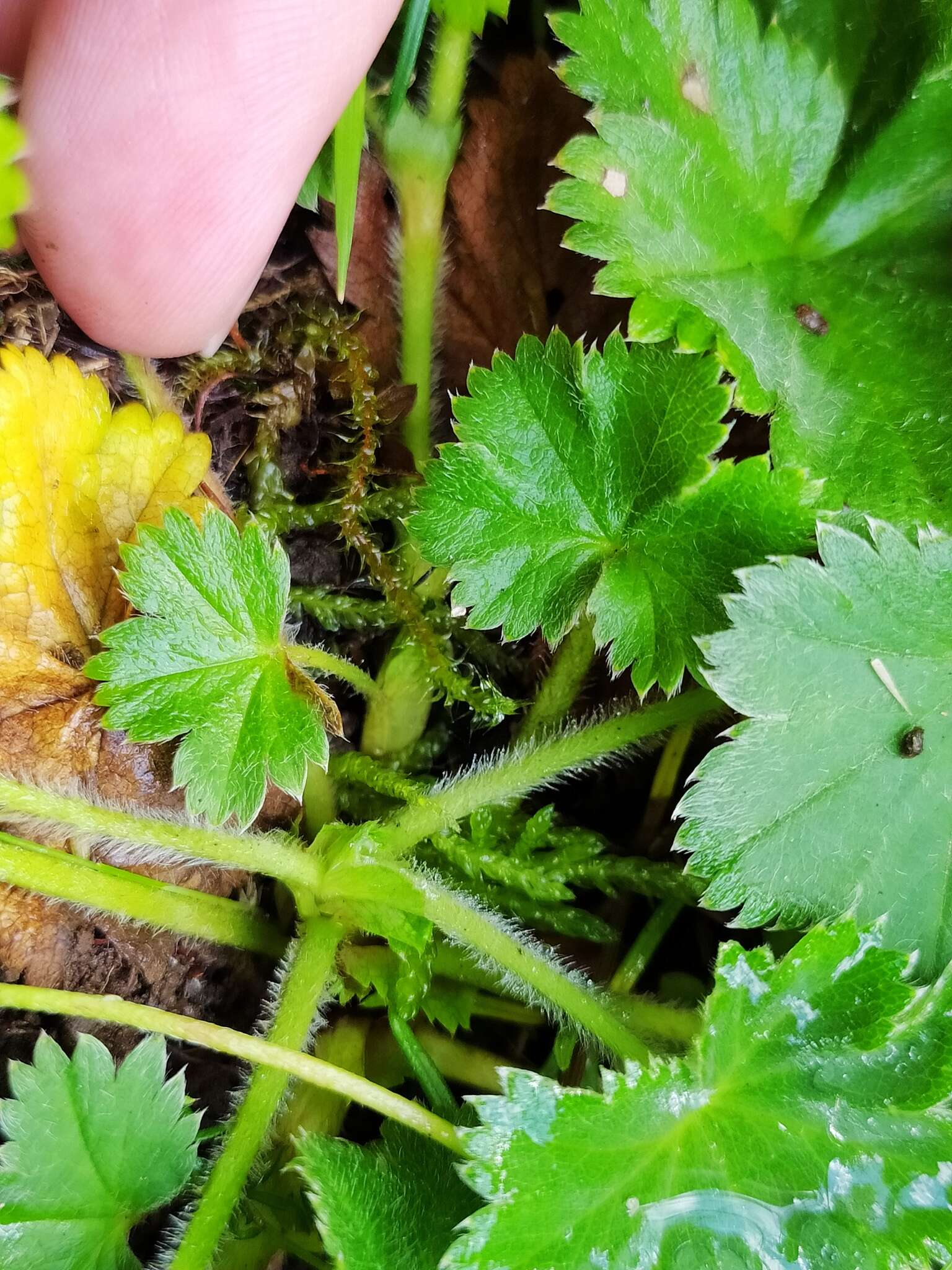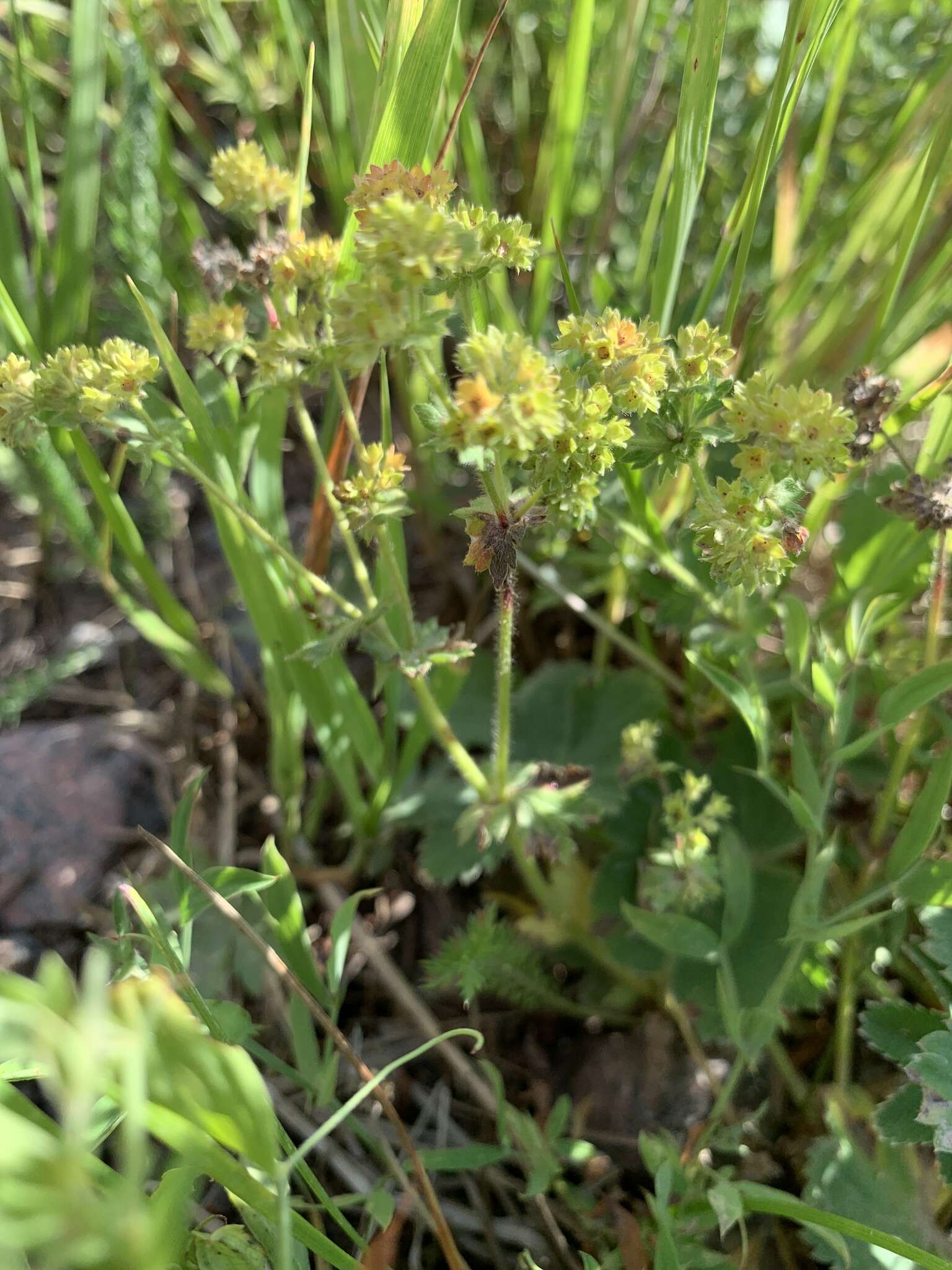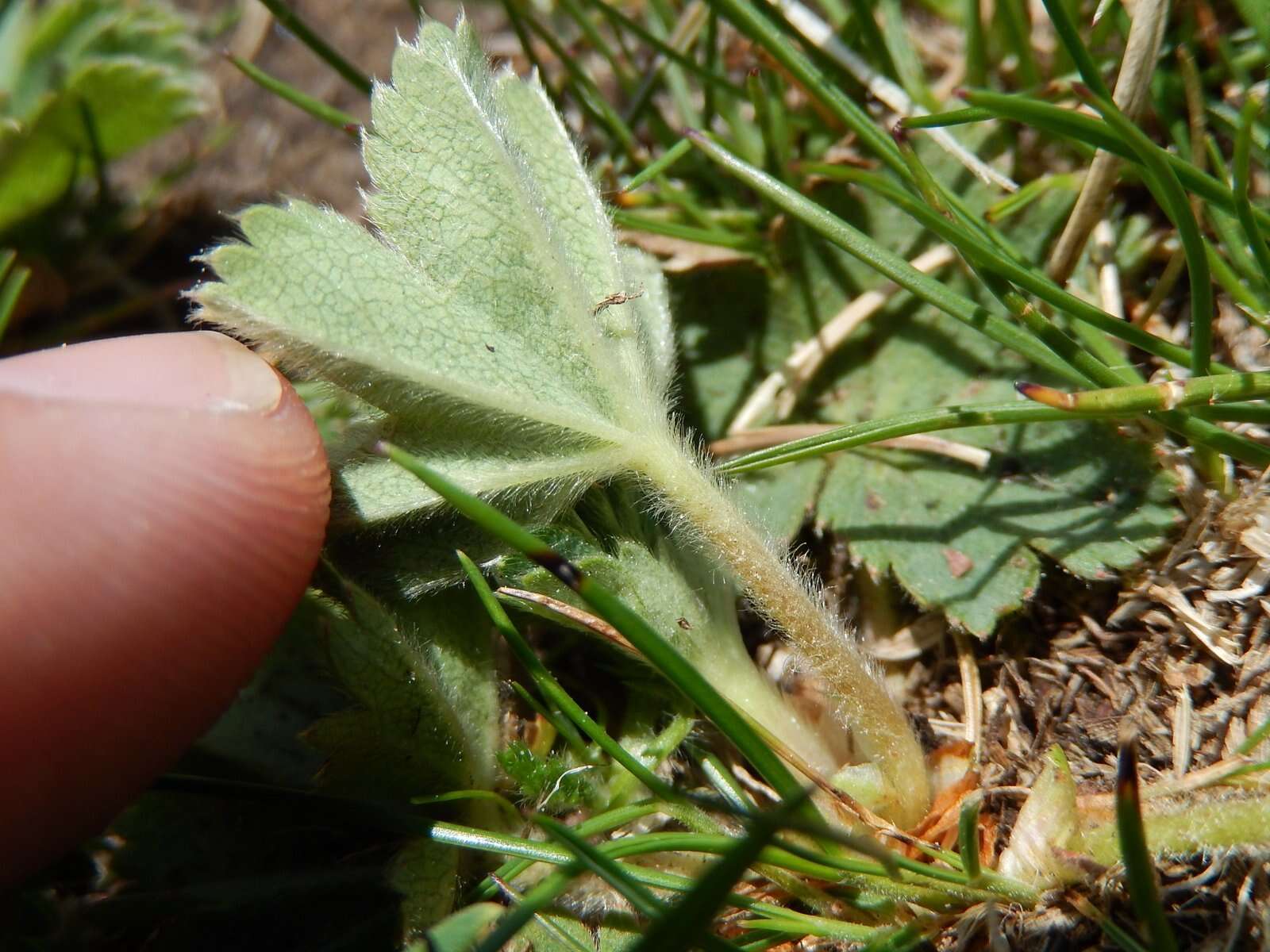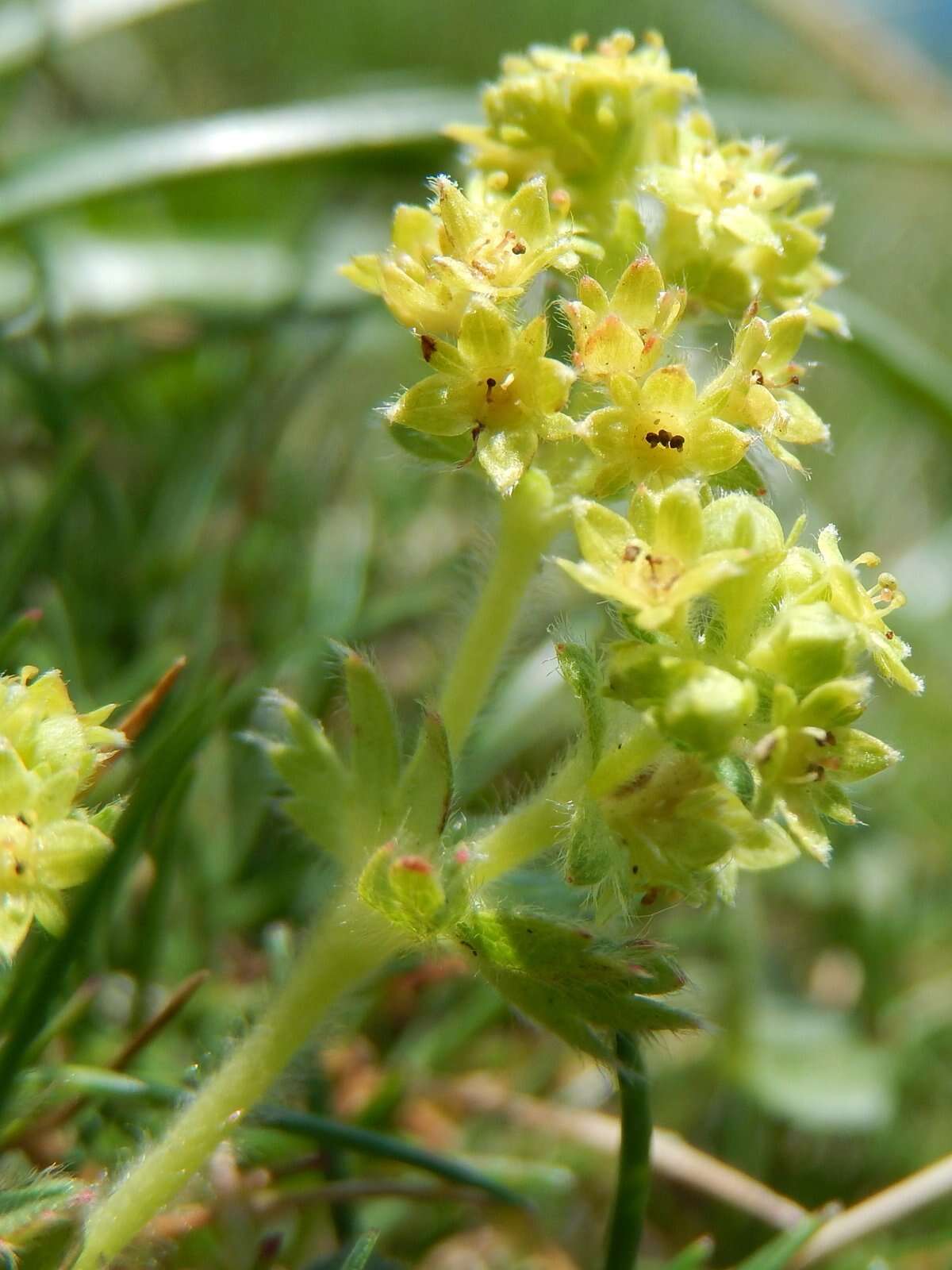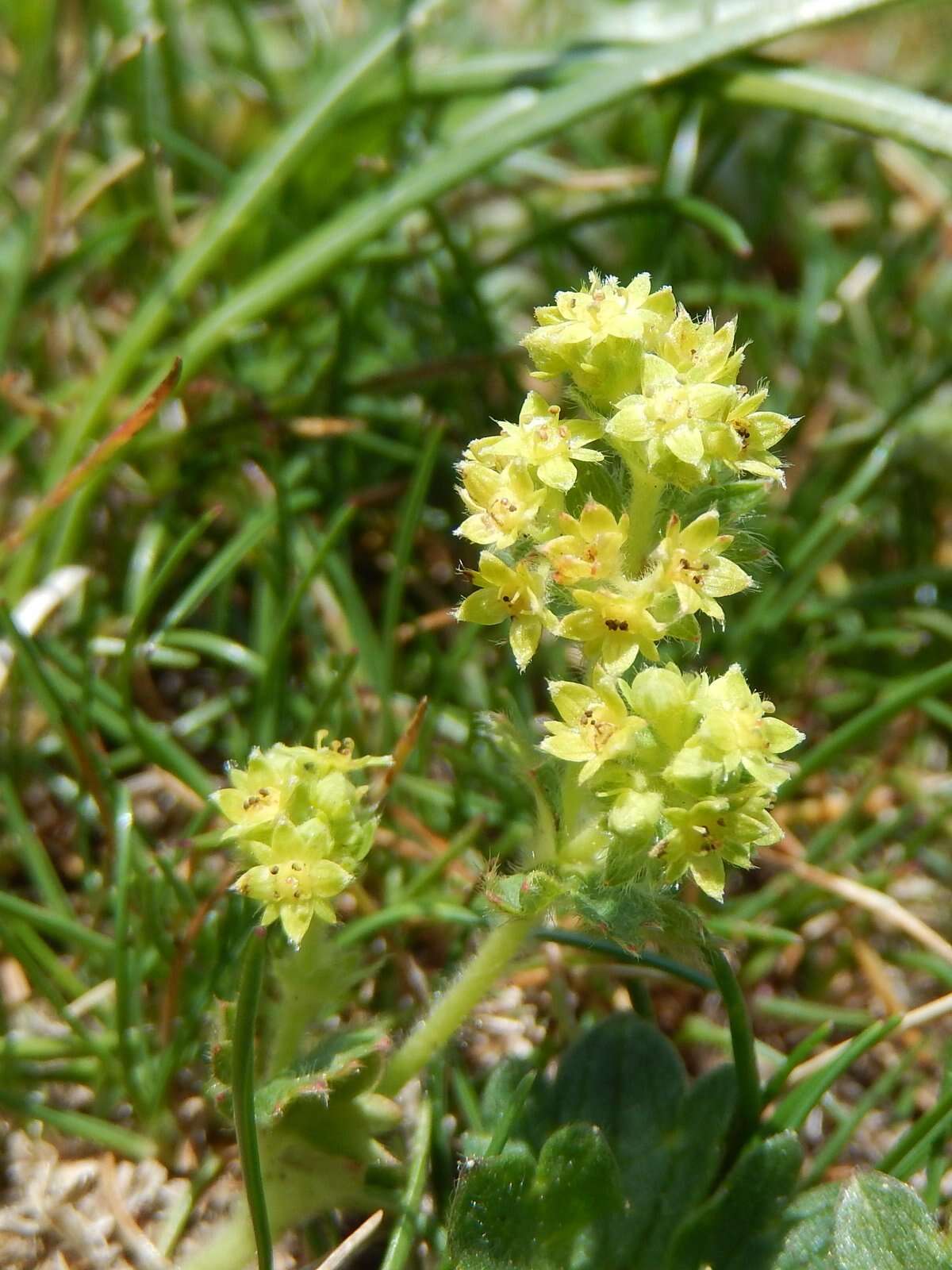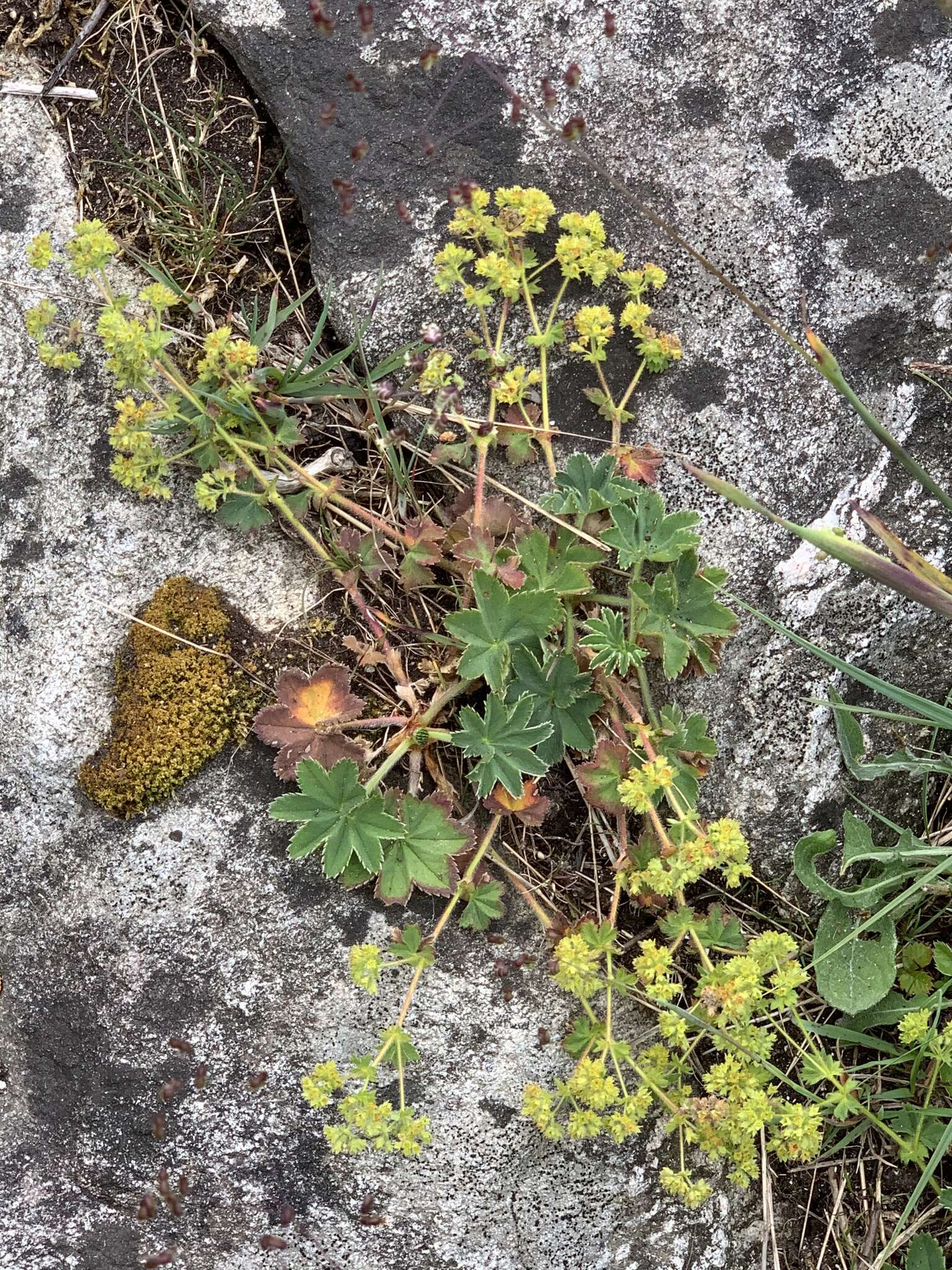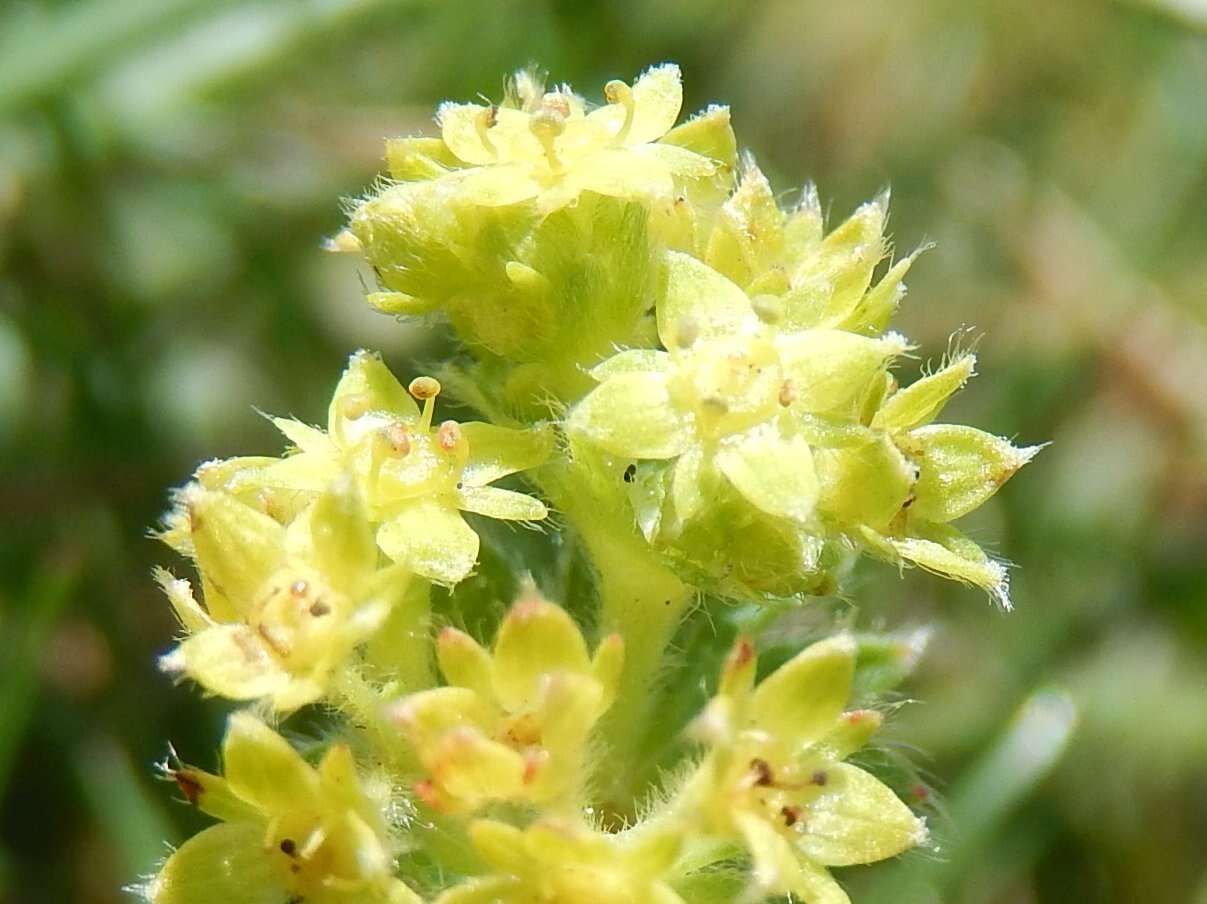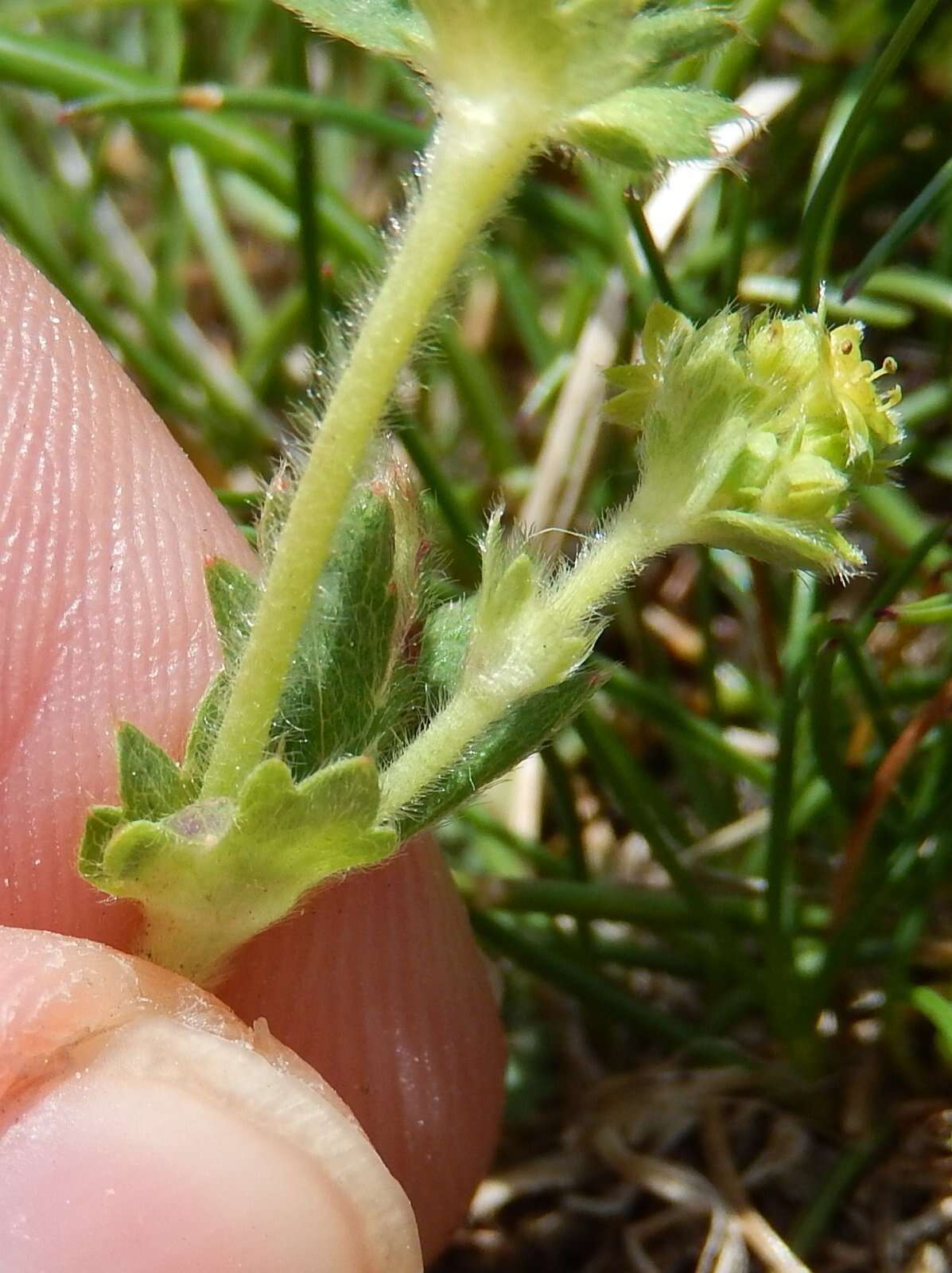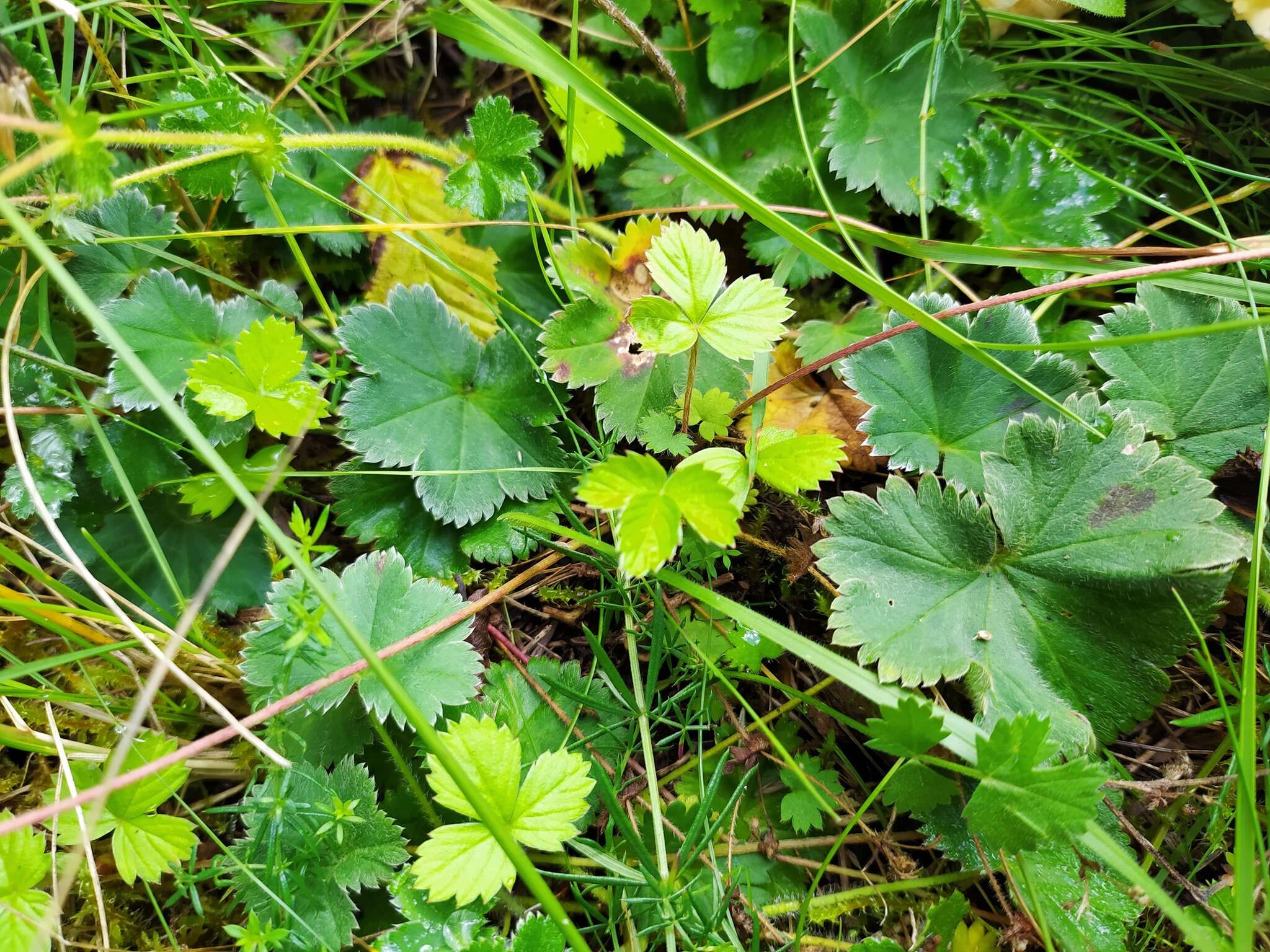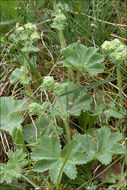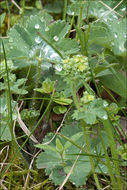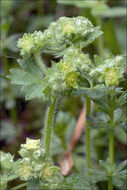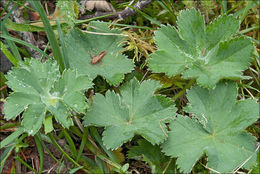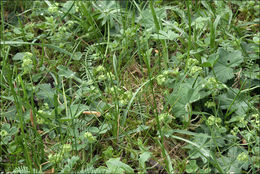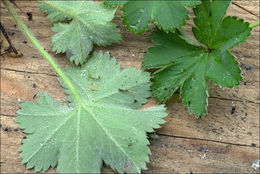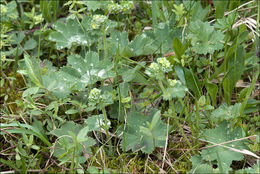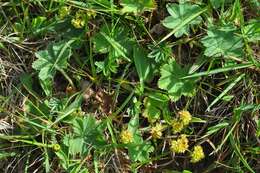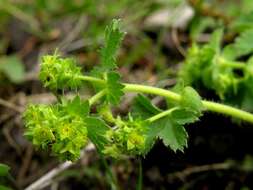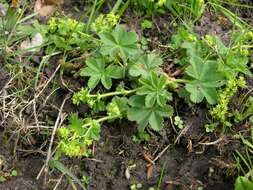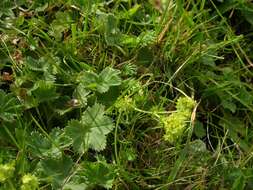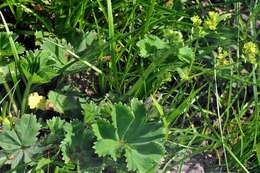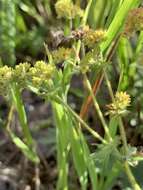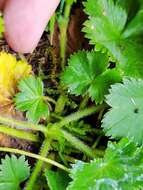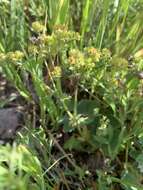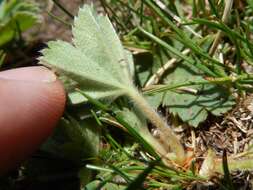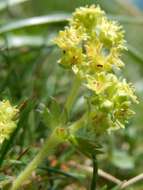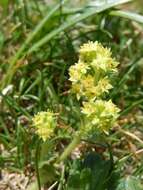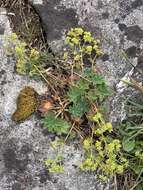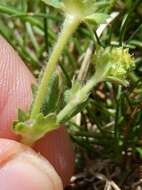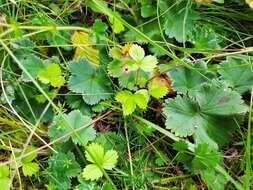-
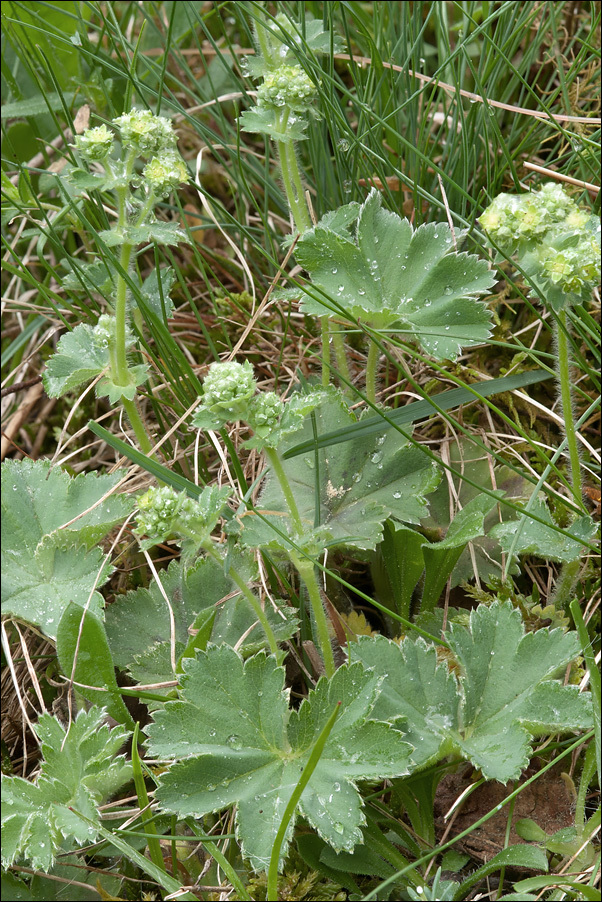
Slo.: puhasta plahtica - Habitat: former pasture with some scattered trees, old overgrown scree slope, slightly southeast inclined; calcareous ground; dry, nutrients poor, shallow soil layer, among low grasses and mosses; partly sunny, exposed to direct rain, average precipitations ~ 3.000 mm/year, average temperature 7-9 deg C, elevation 600 m (1.970 feet),alpine phytogeographical region. - Substratum: soil. - Comment: The genus Alchemilla is, along with the genera Hieracium and, may be also, Rubus, probably the most difficult of all in terms of correct species determination. Nobody really knows how many species it comprises. Some estimate the total number to be about 250. Amateur or semiprofessional botanical books usually 'skip' this problem by describing two or three species or groups (aggregates) only. This, of cause, makes field determination almost hopeless for a botanical amateur. But also in standard botanical works like Ref.: (1), (2), (3) and, for my country, Ref.: (4) authors treat this genus widely differently. To illustrate this, look at the number of species and/or aggregates of this genus described in these works. In Ref.:(1), for example, describing in total about 4.500 plants on over 2.600 printed pages only 12 species and/or aggregates are treated, while, on the other side, over 120 species are described in Ref.:(2) for Austria territory only. The reasons for extreme polymorphism in this genus, causing these ambiguities, are frequent hybrids along with obligate apogam (nonsexual) propagation, resulting in countless morphologically different and stable hybrids. Also insufficient knowledge about the distribution of all these individual 'species' contributes its part to the confusion. So, in spite the fact that I am trying to do my best, don't believe too much in my determinations in this genus. - Description: the whole plant, including inner and outer calyx with flower base, flower stalks, main stalk, ground leaf stalks and leaves (upper and lower side and edges) are densely hairy (lower side denser). Hairs shiny, pilose to villous mostly oriented off and up the stalks. Larger leaves have diameter 3-3.5(4) cm (in May). Flower stalks are up to 10 (15) cm tall. Many plants were present among low grasses and mosses. - Ref.: (1) D. Aeschimann, K. Lauber, D.M. Moser, J.P. Theurillat, Flora Alpina, Vol. 1., Haupt (2004), p 786. (2) M.A. Fischer, W. Adler, K. Oswald, Exkursionsflora sterreich Liechtenstein, Sdtirol, LO Landesmuseen, Linz, Austria (2005), p 501. (3) Rothmaler 3, Exkursionsflora von Deutschland, 11. Aufl., Elsevier, Spectrum (2007), p 242. (4) A. Martini et all., Mala Flora Slovenije, Tehnina Zaloba Slovenije (2007) (in Slovene), p 262.
-
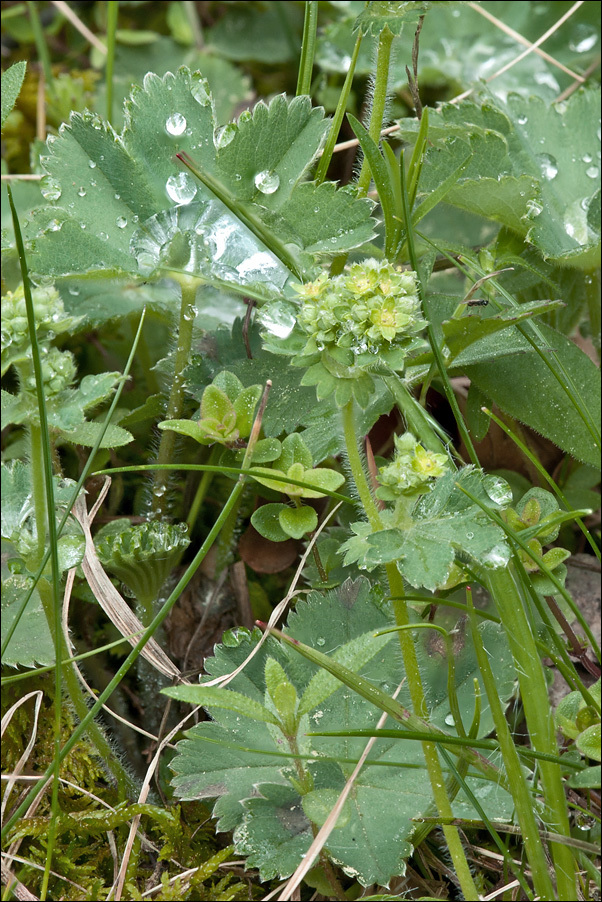
Slo.: puhasta plahtica - Habitat: former pasture with some scattered trees, old overgrown scree slope, slightly southeast inclined; calcareous ground; dry, nutrients poor, shallow soil layer, among low grasses and mosses; partly sunny, exposed to direct rain, average precipitations ~ 3.000 mm/year, average temperature 7-9 deg C, elevation 600 m (1.970 feet),alpine phytogeographical region. - Substratum: soil. - Comment: The genus Alchemilla is, along with the genera Hieracium and, may be also, Rubus, probably the most difficult of all in terms of correct species determination. Nobody really knows how many species it comprises. Some estimate the total number to be about 250. Amateur or semiprofessional botanical books usually 'skip' this problem by describing two or three species or groups (aggregates) only. This, of cause, makes field determination almost hopeless for a botanical amateur. But also in standard botanical works like Ref.: (1), (2), (3) and, for my country, Ref.: (4) authors treat this genus widely differently. To illustrate this, look at the number of species and/or aggregates of this genus described in these works. In Ref.:(1), for example, describing in total about 4.500 plants on over 2.600 printed pages only 12 species and/or aggregates are treated, while, on the other side, over 120 species are described in Ref.:(2) for Austria territory only. The reasons for extreme polymorphism in this genus, causing these ambiguities, are frequent hybrids along with obligate apogam (nonsexual) propagation, resulting in countless morphologically different and stable hybrids. Also insufficient knowledge about the distribution of all these individual 'species' contributes its part to the confusion. So, in spite the fact that I am trying to do my best, don't believe too much in my determinations in this genus. - Description: the whole plant, including inner and outer calyx with flower base, flower stalks, main stalk, ground leaf stalks and leaves (upper and lower side and edges) are densely hairy (lower side denser). Hairs shiny, pilose to villous mostly oriented off and up the stalks. Larger leaves have diameter 3-3.5(4) cm (in May). Flower stalks are up to 10 (15) cm tall. Many plants were present among low grasses and mosses. - Ref.: (1) D. Aeschimann, K. Lauber, D.M. Moser, J.P. Theurillat, Flora Alpina, Vol. 1., Haupt (2004), p 786. (2) M.A. Fischer, W. Adler, K. Oswald, Exkursionsflora sterreich Liechtenstein, Sdtirol, LO Landesmuseen, Linz, Austria (2005), p 501. (3) Rothmaler 3, Exkursionsflora von Deutschland, 11. Aufl., Elsevier, Spectrum (2007), p 242. (4) A. Martini et all., Mala Flora Slovenije, Tehnina Zaloba Slovenije (2007) (in Slovene), p 262.
-

Slo.: puhasta plahtica - Habitat: former pasture with some scattered trees, old overgrown scree slope, slightly southeast inclined; calcareous ground; dry, nutrients poor, shallow soil layer, among low grasses and mosses; partly sunny, exposed to direct rain, average precipitations ~ 3.000 mm/year, average temperature 7-9 deg C, elevation 600 m (1.970 feet),alpine phytogeographical region. - Substratum: soil. - Comment: The genus Alchemilla is, along with the genera Hieracium and, may be also, Rubus, probably the most difficult of all in terms of correct species determination. Nobody really knows how many species it comprises. Some estimate the total number to be about 250. Amateur or semiprofessional botanical books usually 'skip' this problem by describing two or three species or groups (aggregates) only. This, of cause, makes field determination almost hopeless for a botanical amateur. But also in standard botanical works like Ref.: (1), (2), (3) and, for my country, Ref.: (4) authors treat this genus widely differently. To illustrate this, look at the number of species and/or aggregates of this genus described in these works. In Ref.:(1), for example, describing in total about 4.500 plants on over 2.600 printed pages only 12 species and/or aggregates are treated, while, on the other side, over 120 species are described in Ref.:(2) for Austria territory only. The reasons for extreme polymorphism in this genus, causing these ambiguities, are frequent hybrids along with obligate apogam (nonsexual) propagation, resulting in countless morphologically different and stable hybrids. Also insufficient knowledge about the distribution of all these individual 'species' contributes its part to the confusion. So, in spite the fact that I am trying to do my best, don't believe too much in my determinations in this genus. - Description: the whole plant, including inner and outer calyx with flower base, flower stalks, main stalk, ground leaf stalks and leaves (upper and lower side and edges) are densely hairy (lower side denser). Hairs shiny, pilose to villous mostly oriented off and up the stalks. Larger leaves have diameter 3-3.5(4) cm (in May). Flower stalks are up to 10 (15) cm tall. Many plants were present among low grasses and mosses. - Ref.: (1) D. Aeschimann, K. Lauber, D.M. Moser, J.P. Theurillat, Flora Alpina, Vol. 1., Haupt (2004), p 786. (2) M.A. Fischer, W. Adler, K. Oswald, Exkursionsflora sterreich Liechtenstein, Sdtirol, LO Landesmuseen, Linz, Austria (2005), p 501. (3) Rothmaler 3, Exkursionsflora von Deutschland, 11. Aufl., Elsevier, Spectrum (2007), p 242. (4) A. Martini et all., Mala Flora Slovenije, Tehnina Zaloba Slovenije (2007) (in Slovene), p 262.
-
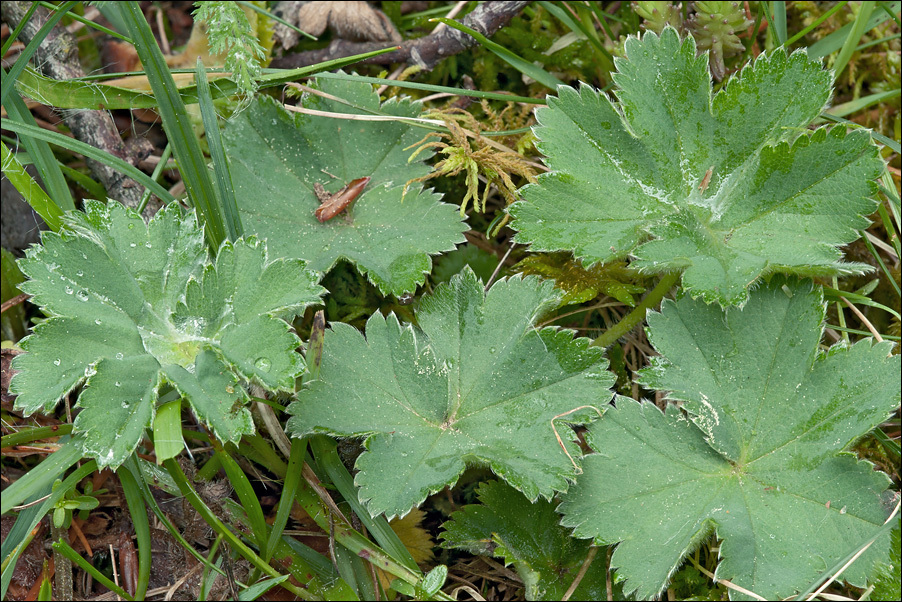
Slo.: puhasta plahtica - Habitat: former pasture with some scattered trees, old overgrown scree slope, slightly southeast inclined; calcareous ground; dry, nutrients poor, shallow soil layer, among low grasses and mosses; partly sunny, exposed to direct rain, average precipitations ~ 3.000 mm/year, average temperature 7-9 deg C, elevation 600 m (1.970 feet),alpine phytogeographical region. - Substratum: soil. - Comment: The genus Alchemilla is, along with the genera Hieracium and, may be also, Rubus, probably the most difficult of all in terms of correct species determination. Nobody really knows how many species it comprises. Some estimate the total number to be about 250. Amateur or semiprofessional botanical books usually 'skip' this problem by describing two or three species or groups (aggregates) only. This, of cause, makes field determination almost hopeless for a botanical amateur. But also in standard botanical works like Ref.: (1), (2), (3) and, for my country, Ref.: (4) authors treat this genus widely differently. To illustrate this, look at the number of species and/or aggregates of this genus described in these works. In Ref.:(1), for example, describing in total about 4.500 plants on over 2.600 printed pages only 12 species and/or aggregates are treated, while, on the other side, over 120 species are described in Ref.:(2) for Austria territory only. The reasons for extreme polymorphism in this genus, causing these ambiguities, are frequent hybrids along with obligate apogam (nonsexual) propagation, resulting in countless morphologically different and stable hybrids. Also insufficient knowledge about the distribution of all these individual 'species' contributes its part to the confusion. So, in spite the fact that I am trying to do my best, don't believe too much in my determinations in this genus. - Description: the whole plant, including inner and outer calyx with flower base, flower stalks, main stalk, ground leaf stalks and leaves (upper and lower side and edges) are densely hairy (lower side denser). Hairs shiny, pilose to villous mostly oriented off and up the stalks. Larger leaves have diameter 3-3.5(4) cm (in May). Flower stalks are up to 10 (15) cm tall. Many plants were present among low grasses and mosses. - Ref.: (1) D. Aeschimann, K. Lauber, D.M. Moser, J.P. Theurillat, Flora Alpina, Vol. 1., Haupt (2004), p 786. (2) M.A. Fischer, W. Adler, K. Oswald, Exkursionsflora sterreich Liechtenstein, Sdtirol, LO Landesmuseen, Linz, Austria (2005), p 501. (3) Rothmaler 3, Exkursionsflora von Deutschland, 11. Aufl., Elsevier, Spectrum (2007), p 242. (4) A. Martini et all., Mala Flora Slovenije, Tehnina Zaloba Slovenije (2007) (in Slovene), p 262.
-
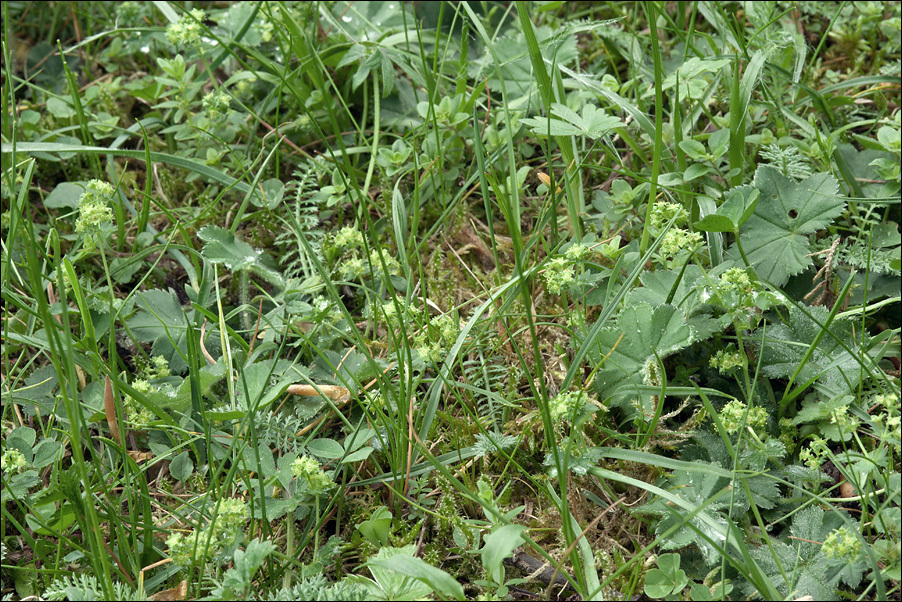
Slo.: puhasta plahtica - Habitat: former pasture with some scattered trees, old overgrown scree slope, slightly southeast inclined; calcareous ground; dry, nutrients poor, shallow soil layer, among low grasses and mosses; partly sunny, exposed to direct rain, average precipitations ~ 3.000 mm/year, average temperature 7-9 deg C, elevation 600 m (1.970 feet),alpine phytogeographical region. - Substratum: soil. - Comment: The genus Alchemilla is, along with the genera Hieracium and, may be also, Rubus, probably the most difficult of all in terms of correct species determination. Nobody really knows how many species it comprises. Some estimate the total number to be about 250. Amateur or semiprofessional botanical books usually 'skip' this problem by describing two or three species or groups (aggregates) only. This, of cause, makes field determination almost hopeless for a botanical amateur. But also in standard botanical works like Ref.: (1), (2), (3) and, for my country, Ref.: (4) authors treat this genus widely differently. To illustrate this, look at the number of species and/or aggregates of this genus described in these works. In Ref.:(1), for example, describing in total about 4.500 plants on over 2.600 printed pages only 12 species and/or aggregates are treated, while, on the other side, over 120 species are described in Ref.:(2) for Austria territory only. The reasons for extreme polymorphism in this genus, causing these ambiguities, are frequent hybrids along with obligate apogam (nonsexual) propagation, resulting in countless morphologically different and stable hybrids. Also insufficient knowledge about the distribution of all these individual 'species' contributes its part to the confusion. So, in spite the fact that I am trying to do my best, don't believe too much in my determinations in this genus. - Description: the whole plant, including inner and outer calyx with flower base, flower stalks, main stalk, ground leaf stalks and leaves (upper and lower side and edges) are densely hairy (lower side denser). Hairs shiny, pilose to villous mostly oriented off and up the stalks. Larger leaves have diameter 3-3.5(4) cm (in May). Flower stalks are up to 10 (15) cm tall. Many plants were present among low grasses and mosses. - Ref.: (1) D. Aeschimann, K. Lauber, D.M. Moser, J.P. Theurillat, Flora Alpina, Vol. 1., Haupt (2004), p 786. (2) M.A. Fischer, W. Adler, K. Oswald, Exkursionsflora sterreich Liechtenstein, Sdtirol, LO Landesmuseen, Linz, Austria (2005), p 501. (3) Rothmaler 3, Exkursionsflora von Deutschland, 11. Aufl., Elsevier, Spectrum (2007), p 242. (4) A. Martini et all., Mala Flora Slovenije, Tehnina Zaloba Slovenije (2007) (in Slovene), p 262.
-
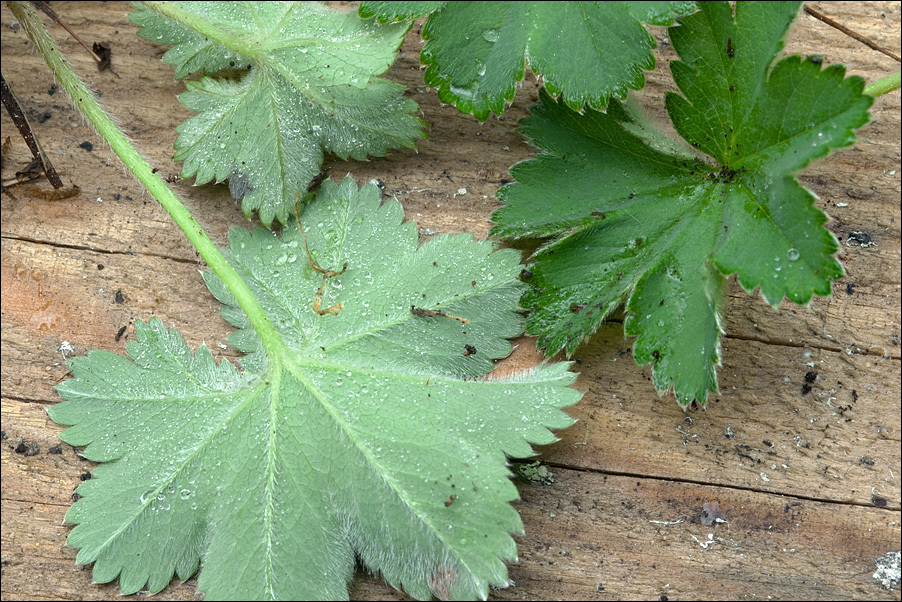
Slo.: puhasta plahtica - Habitat: former pasture with some scattered trees, old overgrown scree slope, slightly southeast inclined; calcareous ground; dry, nutrients poor, shallow soil layer, among low grasses and mosses; partly sunny, exposed to direct rain, average precipitations ~ 3.000 mm/year, average temperature 7-9 deg C, elevation 600 m (1.970 feet),alpine phytogeographical region. - Substratum: soil. - Comment: The genus Alchemilla is, along with the genera Hieracium and, may be also, Rubus, probably the most difficult of all in terms of correct species determination. Nobody really knows how many species it comprises. Some estimate the total number to be about 250. Amateur or semiprofessional botanical books usually 'skip' this problem by describing two or three species or groups (aggregates) only. This, of cause, makes field determination almost hopeless for a botanical amateur. But also in standard botanical works like Ref.: (1), (2), (3) and, for my country, Ref.: (4) authors treat this genus widely differently. To illustrate this, look at the number of species and/or aggregates of this genus described in these works. In Ref.:(1), for example, describing in total about 4.500 plants on over 2.600 printed pages only 12 species and/or aggregates are treated, while, on the other side, over 120 species are described in Ref.:(2) for Austria territory only. The reasons for extreme polymorphism in this genus, causing these ambiguities, are frequent hybrids along with obligate apogam (nonsexual) propagation, resulting in countless morphologically different and stable hybrids. Also insufficient knowledge about the distribution of all these individual 'species' contributes its part to the confusion. So, in spite the fact that I am trying to do my best, don't believe too much in my determinations in this genus. - Description: the whole plant, including inner and outer calyx with flower base, flower stalks, main stalk, ground leaf stalks and leaves (upper and lower side and edges) are densely hairy (lower side denser). Hairs shiny, pilose to villous mostly oriented off and up the stalks. Larger leaves have diameter 3-3.5(4) cm (in May). Flower stalks are up to 10 (15) cm tall. Many plants were present among low grasses and mosses. - Ref.: (1) D. Aeschimann, K. Lauber, D.M. Moser, J.P. Theurillat, Flora Alpina, Vol. 1., Haupt (2004), p 786. (2) M.A. Fischer, W. Adler, K. Oswald, Exkursionsflora sterreich Liechtenstein, Sdtirol, LO Landesmuseen, Linz, Austria (2005), p 501. (3) Rothmaler 3, Exkursionsflora von Deutschland, 11. Aufl., Elsevier, Spectrum (2007), p 242. (4) A. Martini et all., Mala Flora Slovenije, Tehnina Zaloba Slovenije (2007) (in Slovene), p 262.
-
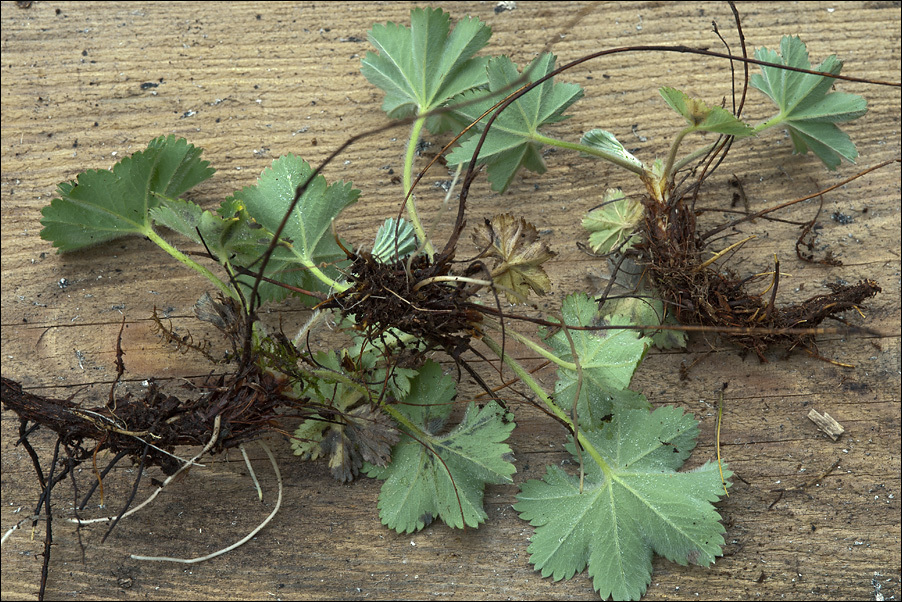
Slo.: puhasta plahtica - Habitat: former pasture with some scattered trees, old overgrown scree slope, slightly southeast inclined; calcareous ground; dry, nutrients poor, shallow soil layer, among low grasses and mosses; partly sunny, exposed to direct rain, average precipitations ~ 3.000 mm/year, average temperature 7-9 deg C, elevation 600 m (1.970 feet),alpine phytogeographical region. - Substratum: soil. - Comment: The genus Alchemilla is, along with the genera Hieracium and, may be also, Rubus, probably the most difficult of all in terms of correct species determination. Nobody really knows how many species it comprises. Some estimate the total number to be about 250. Amateur or semiprofessional botanical books usually 'skip' this problem by describing two or three species or groups (aggregates) only. This, of cause, makes field determination almost hopeless for a botanical amateur. But also in standard botanical works like Ref.: (1), (2), (3) and, for my country, Ref.: (4) authors treat this genus widely differently. To illustrate this, look at the number of species and/or aggregates of this genus described in these works. In Ref.:(1), for example, describing in total about 4.500 plants on over 2.600 printed pages only 12 species and/or aggregates are treated, while, on the other side, over 120 species are described in Ref.:(2) for Austria territory only. The reasons for extreme polymorphism in this genus, causing these ambiguities, are frequent hybrids along with obligate apogam (nonsexual) propagation, resulting in countless morphologically different and stable hybrids. Also insufficient knowledge about the distribution of all these individual 'species' contributes its part to the confusion. So, in spite the fact that I am trying to do my best, don't believe too much in my determinations in this genus. - Description: the whole plant, including inner and outer calyx with flower base, flower stalks, main stalk, ground leaf stalks and leaves (upper and lower side and edges) are densely hairy (lower side denser). Hairs shiny, pilose to villous mostly oriented off and up the stalks. Larger leaves have diameter 3-3.5(4) cm (in May). Flower stalks are up to 10 (15) cm tall. Many plants were present among low grasses and mosses. - Ref.: (1) D. Aeschimann, K. Lauber, D.M. Moser, J.P. Theurillat, Flora Alpina, Vol. 1., Haupt (2004), p 786. (2) M.A. Fischer, W. Adler, K. Oswald, Exkursionsflora sterreich Liechtenstein, Sdtirol, LO Landesmuseen, Linz, Austria (2005), p 501. (3) Rothmaler 3, Exkursionsflora von Deutschland, 11. Aufl., Elsevier, Spectrum (2007), p 242. (4) A. Martini et all., Mala Flora Slovenije, Tehnina Zaloba Slovenije (2007) (in Slovene), p 262.
-
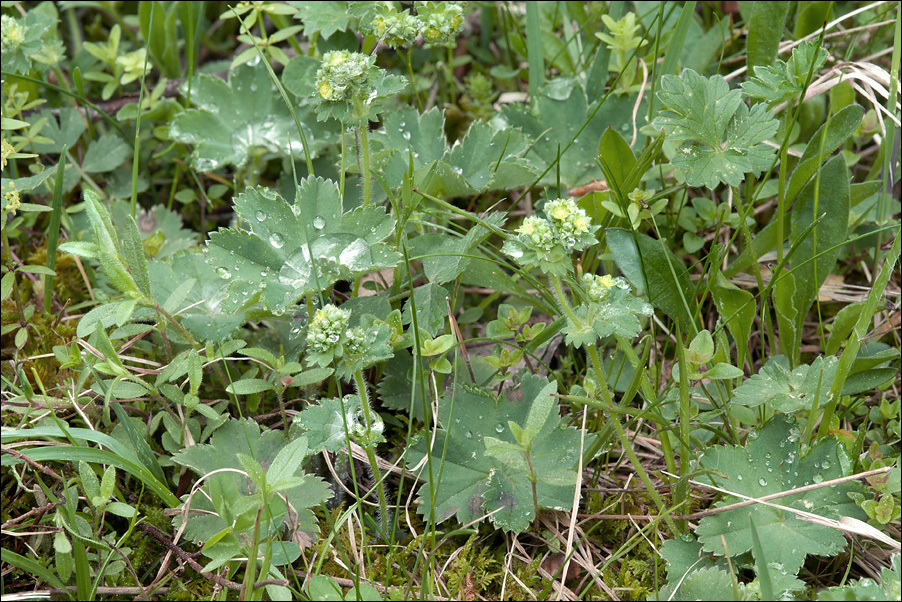
Slo.: puhasta plahtica - Habitat: former pasture with some scattered trees, old overgrown scree slope, slightly southeast inclined; calcareous ground; dry, nutrients poor, shallow soil layer, among low grasses and mosses; partly sunny, exposed to direct rain, average precipitations ~ 3.000 mm/year, average temperature 7-9 deg C, elevation 600 m (1.970 feet),alpine phytogeographical region. - Substratum: soil. - Comment: The genus Alchemilla is, along with the genera Hieracium and, may be also, Rubus, probably the most difficult of all in terms of correct species determination. Nobody really knows how many species it comprises. Some estimate the total number to be about 250. Amateur or semiprofessional botanical books usually 'skip' this problem by describing two or three species or groups (aggregates) only. This, of cause, makes field determination almost hopeless for a botanical amateur. But also in standard botanical works like Ref.: (1), (2), (3) and, for my country, Ref.: (4) authors treat this genus widely differently. To illustrate this, look at the number of species and/or aggregates of this genus described in these works. In Ref.:(1), for example, describing in total about 4.500 plants on over 2.600 printed pages only 12 species and/or aggregates are treated, while, on the other side, over 120 species are described in Ref.:(2) for Austria territory only. The reasons for extreme polymorphism in this genus, causing these ambiguities, are frequent hybrids along with obligate apogam (nonsexual) propagation, resulting in countless morphologically different and stable hybrids. Also insufficient knowledge about the distribution of all these individual 'species' contributes its part to the confusion. So, in spite the fact that I am trying to do my best, don't believe too much in my determinations in this genus. - Description: the whole plant, including inner and outer calyx with flower base, flower stalks, main stalk, ground leaf stalks and leaves (upper and lower side and edges) are densely hairy (lower side denser). Hairs shiny, pilose to villous mostly oriented off and up the stalks. Larger leaves have diameter 3-3.5(4) cm (in May). Flower stalks are up to 10 (15) cm tall. Many plants were present among low grasses and mosses. - Ref.: (1) D. Aeschimann, K. Lauber, D.M. Moser, J.P. Theurillat, Flora Alpina, Vol. 1., Haupt (2004), p 786. (2) M.A. Fischer, W. Adler, K. Oswald, Exkursionsflora sterreich Liechtenstein, Sdtirol, LO Landesmuseen, Linz, Austria (2005), p 501. (3) Rothmaler 3, Exkursionsflora von Deutschland, 11. Aufl., Elsevier, Spectrum (2007), p 242. (4) A. Martini et all., Mala Flora Slovenije, Tehnina Zaloba Slovenije (2007) (in Slovene), p 262.
-
Katbjerg Odde, Jylland, Danmark
-
Katbjerg Odde
-
Katbjerg Odde
-
Kystskrænt nær Hadsund, Jylland, Danmark
-
Vrå VNV Hadsund, Jylland, Danmark
-
-
-
-
-
-
-
-
-
-
-

